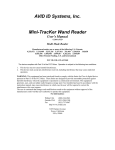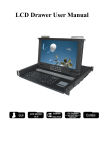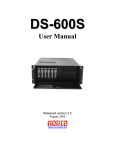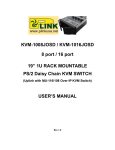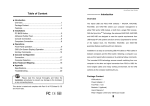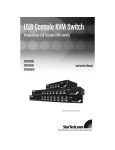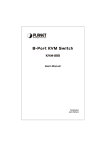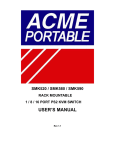Download LCD Drawer User Manual
Transcript
LCD Drawer User Manual NORCO S.E.A. PTE LTD GST Registration No.: 200901437Z Tel: (65) 6853 0809 Fax: (65) 6853 0153 Company Registration No. : 200901437Z 20 Woodlands Link, #09-23, Woodland East Ind’ Estate, Singapore 738733 Website: www.sg-norco.com This manual, covering various aspects of the equipment such as installation, setup and cascade, will help you make full use of this LCD KVM Drawer. Please read this manual carefully and install and operate the equipment according to the manual to avoid damage to this product its accessories. Product package includes following items: 1 * 15” or 17’’ LCD KVM Drawer; 1 * AC Power Cord 1 * Rack installation bracket ( one pair ) 1 * CD (USER’S manual) Please check items above. If any item is missing or damaged, please contact your dealer promptly. Use for product models of followings, KVM-1501COMBO-S KVM-1508COMBO-S KVM-1516COMBO-S KVM-1701COMBO-S KVM-1708COMBO-S KVM-1716COMBO-S NORCO S.E.A. PTE LTD GST Registration No.: 200901437Z Tel: (65) 6853 0809 Fax: (65) 6853 0153 Company Registration No. : 200901437Z 20 Woodlands Link, #09-23, Woodland East Ind’ Estate, Singapore 738733 Website: www.sg-norco.com -1- Table of contents 1. BRIEF INTRODUCTION …………………………………………………..... 3 2. FEATURES ……………………………………………….…………………… 4 3. SPECIFICATIONS ……………………………………………………………. 5 4. INSTALLATION ………………………………………………………………. 6 5. USAGE ( Hotkey Commands and OSD Operations ) ………………….. 9 6. CERTIFICATIONS……………………………………………………………. 17 NORCO S.E.A. PTE LTD GST Registration No.: 200901437Z Tel: (65) 6853 0809 Fax: (65) 6853 0153 Company Registration No. : 200901437Z 20 Woodlands Link, #09-23, Woodland East Ind’ Estate, Singapore 738733 Website: www.sg-norco.com -2- BRIEF INTRODUCTION Short-depth LCD KVM console control panel integrates keyboard, LCD display and touch pad in a drawer type worktable and provides a convenient space-saving operation mode for KVM switch technology. The cover is an LCD display, while the base is keyboard and touchpad. buckles on the left and right are moved aside to open the cover. It can be operated once the KVM module is pulled out. Once the operation is completed, push the KVM module back to the rack. It is a control device integrating 15” or 17’’ LCD, 89-key keyboard, touchpad mouse and 8-port or 16-port mixed connection KVM. You can access multiple hosts using the LCD console while saving money and efforts. A single LCD KVM can control up to 8 hosts, or up to 16 hosts. In addition, both have independent cascade connection port, so 8 port consoles can be connected in series to control 512 hosts, and 16 port consoles can be connected in series to control 2048 hosts. Since LCD KVM series supports hosts of both PS/2 and USB port, KVM cable of PS/2 or USB connector can be selected for hosts depending on cables connecting the switcher and host. Major features include OSD menu, password security mechanism, hotkey control and auto-scanning. Keyboard and mouse simulation can boot computers at the same time. All hosts connected can be accessed conveniently via OSD (On Screen Display) activated by keyboard or through hotkey combination input. The auto-scanning feature can automatically scan and monitor operation status of each host connected. It is simple and convenient to install the LCD KVM, just inserting cables to corresponding ports. No installation disk or complicated installation program is needed, and no compatibility problem exists. LCD KVM series is the best choice to save time and efforts. Since all hosts can be controlled from a single main control terminal, using the LCD KVM console: (1) avoids the cost of keyboard, mouse and monitor of each host; (2) saves work space; (3) saves power; (4) saves the trouble of moving from one computer to another. * For Mac and Sun hosts, USB cable must be used for connection. * - 3- FEATURES The console with 15” or 17’’ LCD display is integrated to a drawer type worktable of 1U height to facilitate rack installation. ● ● Support combo (PS/2 & USB) interface for connecting to computer ports conveniently ● Support MS windows, Netware, Unix, and Linux Support iMAC, Power MAC and Sun Micro Systems with USB connection. ● No Software Required --- easy computer selection via On Screen Display (OSD) Menu, Push Buttons, and Hotkeys ● Provide various Hotkey (Scroll-Lock/ Cap-Lock/ Num-Lock/ L-Alt/ L-Ctrl/ L-Win/ R-Alt/ R-Ctrl/ R-Win) for switching computer port and other control functions, so Hotkey function can be used in various types of keyboards, and to avoid Hotkey duplicate problem. ● ● Provide ACL (Access Control List) security function. Store up to 8 independent user accounts ● Hot Plug --- add or remove connected computers without powering off the LCD Drawer ● Support two user layers, and search computer/server name ● Keyboard status restored when switching computer ● Support Daisy chain(8-layer) & Cascade(2-layer) function -4- SPECIFICATIONS Feature PC Type PC Port Connector PC Ports Max Distance (LCD Drawer to PC) LCD Resolution Daisy Chaining Computer port selection Hotkey LEDs Security Multilingual OSD (on screen display) control Auto-scan intervals Keyboard Emulation Mouse Emulation Max. PC connection Housing Operation Temperature Storage Temperature Specification Combo (PS/2 & USB Connector Support) HDB15 8 / 16 16 feet (5m) 15 ” LCD : 1024 * 768 or 17” LCD : 1280 * 1024 Support Daisy chain(8 - layer) & Cascade(2 - layer) function On Screen Display (OSD) Menu, Hot Key, Push Button Provide various Hotkey (Scroll-Lock/ Cap-Lock/ Num-Lock/ Alt/ Ctrl/ Win Power on & Selection Provide ACL(Access control List) security function, store up 8 independent controllable computers list 8 Languages (English, German, Spanish, Italian, Russian, Japanese, Simplified Chinese, France) 5 ~ 99 Sec PS/2 or USB PS/2 or USB >1024 Metal 0 ~ 50℃ -20 ~ 60℃ Humidity Mechanical 0 ~ 95%, Non-Condensing 19” Rack mount,1U Dimension(W x H x D) 446 x 44 x 406 (mm) -5- LCD Drawer 8 port LCD Drawer Front VIEW Rear VIEW 16 port LCD Drawer Rear VIEW Diagram ( 16 port LCD Drawer ) INSTALLATION On the back of the KVM Switch, each of the 8 / 16 PC ports has a HDB15 type connector. Each cable that comes with the Switch has a 3-in-1 connector at one end and a single HDB15 male connector at the other end. Plug the single connector end of the cable into the KVM PC port, and then plug the other end of cable to a PC VGA port. -6- Figure 1. 3-in-1 DB15 PS2 cable (a) PS/2 computer --- Plug in the PS/2 mouse connector to the computer mouse port, then the PS/2 keyboard connector to computer keyboard port. Figure 2. 2-in-1 DB15 USB Cable (b) . USB computer --- Plug in the USB connector to the computer USB port, This single USB port can handle both keyboard and mouse data. -7- Daisy Chain Connection Use one end of daisy chain cable to connect to the Daisy Chain port of Master KVM switch and connect the other end of daisy chain cable to the Local Console port of the next Slave KVM switch. Please repeat the connection procedures for next Slave KVM switch. You can daisy chain up to eight banks in maximum. Figure 5. Daisy Chain Connection The console OSD menu will show only the port information of the master KVM switch. When the master unit starts up, it will query all daisy chained Slave units, and automatically set up the Bank ID for each Slave unit. So the 7-seg LED on the Master unit will display 1, Slave 1 will display 2, Slave 2 will display 3, and so on. If not so, please reset (press “BANK” and port button) the Master unit to update the Bank ID immediately. Hot Plug function is supported in daisy chain connection. The Master unit will auto -query the daisy chained Slaves every 30 seconds. You can also cascade through computer port. This cascade can work with other brand of KVM switch, but you need to change the Hotkey of slave KVM switches so that the master and slave KVM switches do not use the same Hotkey. -8- Figure 6. Cascade through Computer Port Usage ( Hotkey Commands and OSD Operations ) Buttons The push Buttons 1 ~ 16 : You can simply switch to a port by pressing the corresponding button. For 16 ports LCD Drawer, please press button 1 ~ 16 directly to select the port you want. Hotkey You can conveniently command LCD Drawer through a simple hot key sequence. To send commands to Drawer, you must press the hotkey (default Caps Lock) twice within 2 seconds. You will hear a beep sound confirming entering Hotkey mode. If you do not press any key during Hotkey mode over 2 seconds the Hotkey mode will be escaped and back to Normal state. The default hotkey is Caps Lock but you can change hotkey as your application convenience. If you prefer to use other hotkey, please go to OSD menu and change the default hotkey to the other. The table blow lists all supported hotkey commands. The default hotkey starts from “Caps Lock”+“Caps Lock”, then the keys on the table list. -9- Command Functio Space bar Brings up the OSD overlay screen ↑ Switches to the previous port ↓ Switches to following port [1,2,..,8] bank, ■ The first digit is the Switch bank number, starting [01, 02,.,32] port with “1”. The KVM switch on the daisy chain line is on bank 1 (the Master). A standalone KVM switch is also on bank 1. ■ The second & third digits are port numbers starting with “ 01 ” Pg. Up Switches to the previous bank Pg. Dn Switches to next bank B R S Turns the beep sound on/off For SUPERVISORS that will set the OSD back to the factory default value (except the User Security For SUPERVISORS that activates the Auto-Scan function U For SUPERVISORS that turns the Security function on/off. (Default is off). P Log out, that’s only valid when the security is on. Example #1 – To bring up the OSD overlay window, press Caps Lock”, “Caps Lock”, and the “Space Bar”. Immediately, the OSD overlay screen will appear. The superimposed menu screen is generated by the LCD Drawer, and does not affect your computers or software function in any way. Caps Lock Caps Lock please enter next key in 2 seconds in the Hotkey sequence Space Bar Example #2 – To switch to Bank 1 Port1, press “Caps Lock”, “Caps Lock”, and “1”, “0”, “1”. a Caps Lock Caps Lock 1 0 1 please enter next key in 2 seconds in the Hotkey sequence Actually there are two methods to bring up the OSD overlay window. 1. Activate OSD by press Hotkey --- press Hotkey twice then press Space bar. 2. Activate OSD by Mouse --Press and hold the left button of the mouse and hit the Esc key to show the Status screen. Press and hold the right button of the mouse and hit the Esc key to bring up the Main Menu. - 10 - OSD (On Screen Display) OSD Menu provides a menu-driven interface to control the LCD KVM switch. This OSD Menu has four types of display screens: 1. Login Window --- When powering on this LCD KVM switch, it will prompt a login window and ask for user name and password. This OSD function can setup one SUPERVISOR and eight USERs. SUPERVISOR can access to all OSD functions. USER can access to port name and port search only. 2. Status screen --- after the log in the Status screen will show up to display the current port settings and Hotkey type. 3. Port Name --- this menu displays port status, and you can switch to other port right here. 4. Main Menu --- there are eight menus to operate. They are listed as below: MAIN MENU Function 01 LANGUAGE OSD language selection 02 PORT NAME EDIT PORT NAME modification 03 PORT SEARCH Quick searching by port name 04 USER SECURITY Change password 05 ACCESS LIST Define user access authority 06 HOTKEY Change Hotkey 07 TIME SETTINGS Modify auto-SCAN time interval 08 OSD MOUSE Modify OSD MOUSE speed Login Window Power on the local console monitor, and power on the KVM Switch by plug in the power adapter. If the Security function is enabled (default is disabled), the Login window will show up waiting for user name and password. The Login window The default is SUPERVISOR and default user name is eight zeros “00000000”. The default password is eight zeros “00000000”. There are case-insensitive, while OSD display fixed in upper case. After login or port switch by panel button, OSD or Hotkey, the Status screen will show up to display the information of current settings -- one digit BANK NUMBER, two-digit PORT NUMBER, PORT NAME, and current Hotkey settings. Pressing any key or moving mouse will let the Status screen disappeared. The selected bank no. The selected port no. The port name The Status screen The selected Hotkey - 11 - Auto-LOGOUT function „ In Login window, if no input for username and password over 1 minute, the screen will disappear. Hit any key to bring up the Login window again. „ At normal operation, if no input from the console keyboard or mouse over 10 minutes the LCD KVM switch will turn off the screen display and show up Login window asking for user name and password. One more minute of keyboard/mouse inactivity, the monitor will be turned off The first page shows the current port name and the selected port, and the operation hint. The selected bank The selected port Operation Hint User Level Auto-Scan Interval OSD Function Key F1 Firmware Version Description Go to the Main Menu To log out the OSD. If Security is enabled it will F2 F3 show up the Login window waiting for username and password. If Security is disabled it will show up the Status window Previous Menu Enter Switch to the selected port ↑ / Select the port (press Enter to switch) PgUp Previous Bank PgDn Next Bank Esc Exit 1 Show ports 01 ~ 08 2 Show ports 09 ~ 16 3 Show ports 17 ~ 24 4 Show ports 25 ~ 32 - 12 - ■ USER --- There are two types of user levels: SUPERVISOR and USER. The default is SUPERVISOR. SUPERVISOR can setup and change the OSD settings at Main Menu. USER can only do the port switch and port search. ■ SCAN TIME --- This is the time interval for auto-scan function. When auto-scan function is activated, the KVM switch will auto-scan the host port one by one in the interval as setting. Notice that the port without connecting to a computer/server will be skipped over on the scan. ■ The numeric keypad is not supported, while in OSD screen, the arrow keys, PgUp, PgDn, and Enter keys are supported. Main Menu There are eight menus to choose from. LANGUAGE The OSD supports eight languages: English, French, German, Italian, Spanish, Simplified Chinese, Japanese, and Russian. The default language is ENGLISH. Moving the cursor by keyboard (Up Arrow key or the Down Arrow key) or mouse to select the language you like. - 13 - PORT NAME EDIT The first line bar is Bank number, following lines are port name list. Use keyboard (Up Arrow key / Down Arrow key ) or mouse to select the port. After select the port, you can either press the Enter Key, or move the cursor to port name and double click left button of mouse to switch the port immediately. Press PgUp key or PgDn key for selecting the previous or next Bank. Press Enter key for editing port name. Press Esc key to cancel the editing without any change or press Enter key to complete the editing. PORT SEARCH Search the computer by port name. Enter “*” will show the all the port names. USER SECURITY There are two types of user levels: SUPERVISOR and USER. There is one SUPERVISOR and up to eight USERs can be configured. Press the Enter key or right button of mouse for editing. The left-top “S” means SUPERVISOR, and “1”, “2”, “3”,…., “8” mean USERs. The maximum length of NAME and PASSWORD is eight characters (A~Z and 0~9). - 14 - ACCESS LIST Only SUPERVISOR can configure the ACCESS LIST. The first column is the port number, following the server/computer name list. The last 8 columns are the access right of each user. Use the Enter key or left button of mouse to active/deactivate the access right of each port. “X” means to disable access and “O” means to enable access. HOTKEY Some keyboards may not equip with all the special keys. Making sure the key you select is available in you keyboard. TIME SETTINGS When the Auto-Scan function is activated, the LCD KVM switch will auto-scan the host ports one by one in the interval as setting. Notice that the port without connecting to a computer/server will be skipped over on the scan. The interval range is 5 ~ 99 seconds, and the default interval is 10 seconds. Press “Enter” key to save the SCAN TIME setting. - 15 - OSDMOUSE You can change the moving speed of mouse cursor in this item There are three levels to choose from The fastest moving speed is "FAST', the second is "MIDDLE" and the slowest is "SLOW''. Using Up Arrow key / Down Arrow key on keyboard to move highlight bar to the wished speed. Press the Enter key to go into effect. .16 . Certifications FCC This equipment has been tested and found to comply with Part 15 of the FCC Rules. Operation is subject to the following two conditions: (1) This device may not cause harmful interference (2) This device must accept any interference received. Include interference that may cause undesired operation. CE This equipment is in compliance with the requirements of the following regulations: EN 55 022: CLASS B. RoHS All contents of this package, including products, packing materials and documentation comply with RoHS. Trademarks: All the companies, brand names, and product names referred to this manual are the trademarks or registered trademarks belonging to their respective companies - 17 -





















